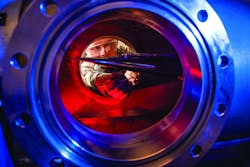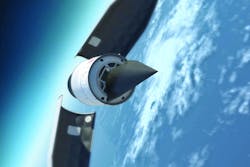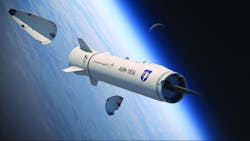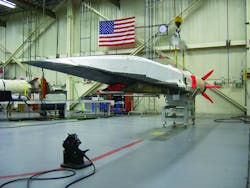By Megan Crouse
NASHUA, N.H. - It’s hard to stop something moving at Mach 5, to say the least. Electronics packages for hypersonic vehicles need to stand up to extraordinary speed, temperature, and pressure. With today’s hypersonic weapons engineered with throttleable rocket engines for mid-range attack or defense against other missiles or the ships that carry them, even more challenges come along for the flight. The story behind making reliable electronics for these conditions stretches from the 1940s to today’s defense projects.
Hypersonic flight technically occurs between Mach 5 and Mach 10 — greater than the speed of sound. At these speeds the molecular bonds of the air must be considered in engineering, as they can change the magnitude of the forces the air exerts on the vehicle. At higher speeds, an electronically charged plasma forms around the vehicle. Manned vehicles also have traveled at these speeds: experimental aircraft such as NASA’s X-43 in the 2000s or the Lockheed X-17, as well as the Space Shuttle orbiter.
Occasionally you might see a report of a proposed hypersonic passenger flight that could bring people from Los Angeles to Tokyo in two hours. For now, the most urgent area of development for this technology has been defense, specifically missiles and warheads. But NASA researchers also are working on commercial aircraft at these speeds, as they have off and on since the X-15 in 1967.
“High-speed flight represents the next frontier in commercial passenger travel and has the potential to radically impact how people interact,” Chuck Leonard, project manager of NASA’s Hypersonic Technology Project, said in March 2021 in reference to a collaboration on hypersonic plane concepts with aerospace company Hermeus.
Today’s defense applications
Today’s global powers continue their race to the fastest-responding missiles. In 2019, Popular Mechanics predicted that Russia would be the first global powerwith hypersonic weapons. Designed to attack ocean or land targets, hypersonic missiles would make payloads — including nuclear weapons — very difficult to intercept. The Russian navy tested the 3M22 Zircon — a scramjet cruise missile which can travel at Mach 8 or 9 — starting in 2020 and reported a successful launch in the White Sea and Barents Sea in October.
This is another weapon in Russia’s suite of hypersonic missiles, after the Kinzhal and Avangard glide vehicle, which can reach speeds as fast as Mach 27. Like other hypersonic weapons, the main tactical advantage to deploying or countering these is their ability to maneuver in low altitudes at very high speeds.
China allegedly has two hypersonic-capable missiles: the medium-range DF-17 hypersonic glide vehicle, which debuted in a military parade in Beijing in 2019, and the experimental Starry Sky-2 aircraft. The DF-17 appears to be road-mobile, which presents a problem for targeting these systems prior to launch.
A March 2020 Beijing Institute of Technology paper proposed that the next escalation in this area might be “hypersonic swarms,” or drone vehicles that fly in hypersonic packs. This runs into the problems of enabling hypersonic to communicate, so the paper focuses on getting the proposed drones to talk to each other over a novel mobile wireless network. While this seems to be confined to academic halls for now, the idea of many small vehicles instead of one large one may be an area to watch for.
To reply to a threat like that, the opposition needs equally fast technology, as well as hair-trigger, high-altitude radar. For example, L3Harris is working on a $121 million U.S. Missile Defense Agency contract for hypersonic and ballistic tracking from space. It will demonstrate the company’s solution for the Hypersonic and Ballistic Tracking Space Sensor (HBTSS) program, which provides eyes in the sky — specifically, infrared sensors and advanced processing capability for low-Earth orbit space architecture for missile warning and defense.
Throttleable rockets also come into play here, as they enable greater maneuverability when it comes to responding to variable-range threats like other highly-maneuverable hypersonic missiles and the ships that launch them. In particular, the U.S. Navy is calling for missiles that can launch attacks around the world in less than an hour, including other hypersonic weapons and the ships from which they would be launched. The Navy issued a sources-sought notice for the Navy Conventional Prompt Strike Weapon System Platform-Specific Development and Production project in March 2021 to integrate hypersonic weapons on three stealthy Zumwalt-class destroyer surface warships.
In addition, in June 2019, the U.S. Defense Advanced Research Projects Agency (DARPA) in Arlington, Va., issued a solicitation for the Operational Fires (OpFires) Integrated Weapon System project. The finished product would need to “penetrate modern enemy air defenses and rapidly engage time-sensitive targets,” including incoming missiles. This gives them the ability to defend quickly in a rapidly changing mission, such as an incoming strike from a mobile nuclear missile. The contract was offered to Lockheed Martin, which began work on it in early 2020.
This is just one of a suite of hypersonic weapons the U.S. is working on for different capabilities and use cases. The U.S. Air Force is working with DARPA on a Hypersonic Air-breathing Weapon Concept hypersonic missile, or HAWC — although this may be too large to mount on an aircraft carrier elevator. Another hypersonic project called Screaming Arrow called for a scramjet vehicle launched with a rocket engine first before the scramjet takes over at hypersonic speeds.
At the same time, Lockheed Martin is working on the AGM-183A Advanced Rapid Response Weapon (ARRW), designed to travel at speeds to Mach 20, truly competitive among today’s designs, and a Hypersonic Conventional Strike Weapon (HCSW). At time of writing the AGM-183A appeared to be gearing up for its first test flight on the West Coast, according to Federal Aviation Administration alerts reported by The Drive.
The rise and fall of Screaming Arrow
In the U.S., the most recent high-profile project in this area is the Office of Naval Research’s Screaming Arrow. A hypersonic anti-ship missile, a solicitation notice in March 2020 called for an air-breathing scramjet-powered, weapon to mount aboard a F/A 18 E/F Super Hornet multirole fighter jet. Documentation from the Department for Aviation, Force Projection and Integrated Defense asked for proposals, but as of March 5, 2021 the solicitation was cancelled.
That doesn’t mean the entire project was cancelled — it also might have been moved to a higher classification. The project covered the gamut of the weapon’s capabilities, from launch to impact.
As defense technology filters down into industry, so too does industry work on finding the answer to military size, weight, and power (SWaP) needs.
SWaP considerations
At hypersonic speeds, systems designers must consider vibration, pressure, and temperature carefully. “They want to be sure you’re not drawing a lot of power out of that battery or requiring a lot of weight,” says Patrick Quinn, senior product line manager for data acquisition at Curtiss-Wright Corp. based in Davidson, N.C. Customers are asking for low power consumption from data acquisition products, which can be achieved by making sure it’s possible to turn off channels that aren’t being used and other established methods.
“For hypersonic missiles, electronics SWaP are critical parameters,” said Emil Kheyfets, director of military and aerospace products and director of engineering forAitech Defense Systems in Chatsworth, Calif.. “Electronics need to be small, light and low power to minimize the amount of energy required to achieve and to maintain hypersonic speed.
“Besides SWaP, other high-altitude operating conditions should be taken into consideration, like cold start temperatures (well below typical -40 degrees C) and Single Event Effect (SEE) mitigation techniques for active components,” Kheyfets says.”
In regards to temperature, Curtiss-Wright’s Quinn compares the altitude at which hypersonic vehicles fly to conditions on board a commercial airplane. “There’s not a lot of windows you can open up in an airplane to breathe. We have to be able to fly in an almost airless environment, which means … we rely on transporting our heat off into a shroud or another part of the vehicle.” This is not particular to hypersonic flight, but is one of numerous known aerospace considerations.
Quinn also noted that the data acquisition electronics he works with are conduction cooled, with other aspects of the design channeling heat away from circuit boards. Liquid cooling may be useful for other applications, depending on need.
“One thing I’ve noticed from hypersonics that we don’t see from other customers is the type of sensors they use — a lot of heat flux sensors,” Quinn says.
As well as extreme thermal, mechanical, and chemical environments, the equipment needs to stand up to shock waves. With those come scalding heat, which furthermore can lead to chemical reactions such as ionizing molecules — a factor in radio blackouts. Curtiss-Wright Defense Solutions details some of these challenges in the white paper “Flight Test Instrumentation Solutions for Hypersonic Vehicles.”
All of that can cause major problems when it comes to sensors and data collection and retrieval. DARPA created the High Enthalpy Aperture Technology (HEAT)program to focus on the challenges facing RF and infrared apertures on hypersonic missiles and aircraft. Three companies — the General Electric GE Global Research Division in Niskayuna, N.Y.; the Lockheed Martin Corp. Missiles and Fire Control segment in Orlando, Fla.; and the Georgia Tech Research Corp. in Atlanta — won contracts to develop materials to shield sensors from heat and vibration.
Their work will involve developing integrated RF aperture materials, infrared aperture materials, and next-generation aperture materials, including rugged RF radomes and infrared windows. They’ll look into “affordable and manufacturable means of controlling thermo-optical and elastic-optical effects; maintaining desired transmission amplitude and bandwidth; and reducing thermal deformation, mismatch, and radiation.”
When it comes to communications and flight recording, the risk of data loss is high because of telemetry dropout problems that develop at these speeds, according to a February 2021 Curtiss-Wright case study about a hypersonic test bed.
That case included “the need to withstand more severe shock, vibration, and temperatures that equipment onboard a hypersonic vehicle would encounter compared to that experienced on a large aircraft. There was also a need to cope with the conditions found at altitudes above 100,000 feet.”
These components might be custom-built for use in harsh environments, or ruggedized commercial off-the-shelf products adapted to harsh environments. Industry standards like the Cisco IE standards, VITA standards, and many others, provide a baseline for performance in harsh environments. Common military flight test standards include TmNS and IRIG 106, with some overlap between them.
Another major factor in the Curtiss-Wright project was expense. To improve efficiency and reliability, Curtiss-Wright engineers doubled-up on several components. Data recorders gathered information once in real-time, and then again a short time later to double-check on details.
Due to the anticipated need for these to operate at extreme altitudes, variants were optimized for such conditions by removing certain types of capacitors. This helps ensure that the flight test team could monitor the subset of the data being telemetered to ground in real-time while conducting more detailed analysis at a later date on the more complete data set that was recorded onboard in two locations,” wrote the authors, Curtiss-Wright’s Paul Cook; Quinn; and Stephen Willis.
A brief history of hypersonic flight
Curtiss-Wright experts also knew to draw from components that had already been tested in the environment conditions they would face — in this case, their own data acquisition units. Some of this type of equipment has been around for decades. After all, hypersonic flight was first achieved in 1949.
At that time, the first man-made object to travel at these speeds was a multi-stage missile. The WAC Corporal rocket, mounted on top of a German V-2 rocket, reached five times the speed of sound. Not long before that, legendary American test pilot Chuck Yeager had become the first person to break the sound barrier, piloting a Bell X-1 rocket plane in the fall of 1947.
While hypersonic flight may sound exotic, Curtiss-Wright’s Cook and Quinn say that some of the electronics packaging hardware on the inside is fairly traditional, even though the size on the outside has changed as vehicles become smaller in diameter. While there are few constraints on hardware, that’s not the case for power consumption; flight time makes power draw on the battery variable.
That small size does mean companies are drawing from commercial technology makers, who have had plenty of practice over the last decade shrinking the size of electronics components.
“All the vehicles are smaller in diameter, which drives: How do we make things smaller?” Curtiss-Wright’s Cook points out. “We all have cell phones. It took the commercial industry all that money to make them smaller, to make chips to make the boards smaller, the subsystems are much smaller. We’re using the commercial technology — which has gotten very small because of the cell phone industry — in our military application to make our hardware smaller and the vehicles smaller. Everyone benefits from that. That is the trend today.”
Today and into the future
Since those first flights, understanding of the conditions beyond Mach 5 has improved. there is no dramatic visible change in the color of the air or a sound effect between Mach 4.99 and 5.01, as there is with a sonic boom at Mach 1, point out experts at the Smithsonian National Air and Space Museum in Washington. Instead, the important factor is the intensity of the physical phenomenon experienced at speeds beyond Mach 5.
Ruggedizing components sufficiently to operate through these speeds could include changing their internal heating and dissipating heat, which can be difficult. Testing a vehicle or weapon expected to travel at hypersonic speeds can be difficult and expensive. In a white paper on flight test instrumentation for hypersonic vehicles, the Curtiss-Wright authors note that “If the acquisition chassis malfunctions during flight, then the test points will need to be re-flown. This incurs a large expense, especially if the test article is unrecoverable, as is often the case for ordnance testing.”
Data security
Another major factor with military equipment is data security. If a vehicle is intercepted or lost, the rugged or ruggedized sensors must not sacrifice data security for the sake of their unique application. The National Institute of Standards and Technology (NIST) provides certifications for encryption for protecting streaming telemetry data in cases like this. Other specific considerations must be taken when a vehicle is flying outside of the U.S.
“Adversaries may try to intercept things during test flights,” points out Curtiss-Wright’s Cook. “It’s all Ethernet based, and we are always going to have some kind of security risk.”
What’s next? Cook says he expects requirements to involve very low current draws. An upcoming challenge might be changing how to test for these vehicles and components. At the same time, software is getting better and easier to analyze much earlier in the design process, saving time and money. “When we do an analysis of the design they can do a fix much earlier in the development … instead of finding out later after the board has burnt up that they have a problem,” Cook says.
Flight testing, however, is another matter. “The ultimate is how do you demonstrate a vehicle that flies that fast and that far in the Earth today,” Cook says. “We do all our flight tests in the U.S., and they may fly over the Pacific Ocean over U.S.-owned property. To be able to demonstrate a vehicle that flies around the world and gets there in 30 minutes, that’s a bigger challenge for the hypersonic industry. Being able to schedule what countries you are flying through to be able to demonstrate that vehicle is probably much more difficult than it is to design the vehicle to do that.”





